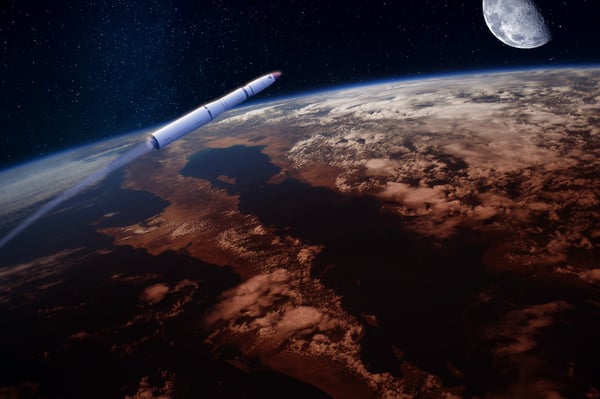Hypersonic systems are garnering renewed attention as countries pursue new capabilities for military and commercial applications that span across air, sea, and land. Hypersonic weapons are faster than the speed of sound and can maneuver in the atmosphere at speeds above Mach-5.
Hypersonic technology itself is not new. Its history goes back more than half a century, well before Sputnik kick off the space race during the Cold War. Since the 1960s, the United States has periodically pursued the development of maneuverable hypersonic weapons, but hurdles such as propulsion, control, and heat resistance proved daunting.
Hypersonic research and development are back in full swing. Both Western and Asian countries are pursuing the development of a new generation of hypersonic systems designed for speed, stealth, and surprise. Hypersonic systems refer to aircraft, missiles, rockets, and spacecraft that can reach speeds within the atmosphere faster than Mach 5, which is nearly 4,000 miles per hour. These systems can be launched from either air, sea, or land.
 Who is Developing Hypersonic systems?
Who is Developing Hypersonic systems?
The United States, Russia, and China are leading the race to develop hypersonic missiles. France and India are close behind, while Japan and Australia are developing the component technologies, in some cases for civilian purposes. The primary reason nations are developing these next-generation hypersonic weapons is that they are difficult to defend against due to their speed, maneuverability, and flight path.
Hypersonic Weapons Today
Today, research and development are ramping up in all areas of hypersonic flight, from efficient propulsion systems to SWaP-enhanced electronics for sensors, guidance, communications, and harsh-environment applications.
New classes of hypersonic capabilities are being developed and explored that involve hypersonic cruise missiles, boost-glide systems, interceptor missiles, reusable aircraft, space launch vehicles, and gun-launched projectiles. Reentry, space lift, and interceptor systems are important hypersonic operational capabilities that continue to be developed.
Hypersonic Weapons Maneuverability
Hypersonic weapons get a lot of attention for their speed but other capabilities make the technology noteworthy. These systems combine the attributes of speed and maneuverability. They fly at low altitudes and can maneuver during the cruise phase, making them harder to defend against. Hypersonic weapons can fly in a flatter trajectory and hit targets at greater speeds. The bottom line is that they are harder to detect and more difficult to shoot down.
Hypersonic Weapons Versus Ballistic Missiles
Simply put hypersonic systems provide military operations the ability for longer ranges with shorter response times. Countries with this capability can evade any defense systems that are now in use. What makes these systems different than ballistic missiles is their ability to maneuver at exceptional speeds, creating unpredictable flight paths. Ballistic missiles, which also can travel at Mach 5 speeds, have set trajectories and limited maneuverability.
Categories of Hypersonic Weapons
There are two main categories of hypersonic weapons: Boost-glide vehicles (BGVs) and hypersonic cruise missiles (HCMs). High-speed, air-breathing engines power hCMs, while BGVs are launched from a rocket and glide along the edge of the atmosphere as they make their way to a target. HCMs often rely on an advanced propulsion system called a scramjet. Boost-glide missiles consist of gliding vehicles mounted on the front of rocket boosters, much like those that launch spacecraft into orbit.
Hypersonic Weapons Engineering Challenges
Designing and deploying systems that go over 60 miles per minute creates many complex engineering and physics challenges. According to Lockheed Martin, there are four big challenges engineers have to take into account:
- Heat – At hypersonic speeds, friction and air resistance create an incredible amount of heat, which needs to be managed through tough but lightweight heat shields and thermal protection systems. Instruments, like sensors and electronics, must also be equipped and protected to stand up to these extreme conditions.
- Advanced Materials – Speed and heat challenges in hypersonics requires new inventions, particularly in advanced materials and composites that can withstand extreme environments.
- Maneuverability – Hypersonic systems must be capable of overcoming a wide range of defenses. Maneuverability is a big challenge that demands extensive calculation and development.
- Communication – Hypersonic flights significant basic operations, such as communications. Personnel need continuous connectivity to operators and decision-makers through global communications and sensor systems that can operate within these high-speed environments.
.jpg)

 News Blog
News Blog

Let Us Know What You Thought about this Post.
Put your Comment Below.